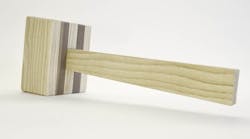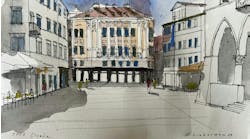Growing up, a memorable rite of passage was the receipt of my first knife. My father handed me a small chipboard box and stressed that I be very careful. Inside the box was a Buck ‘Prince’ - a locking single blade pocketknife made of stainless steel with riveted wooden handle scales. My hand can still recall the contours, edges and satisfying heft of the small tool.
Having opened this prize, my young mind was immediately set on whittling a little figurine from a piece of scrap wood. Predictably, within seconds, the knife jumped across the notch I was working on and found purchase in my thumb, prompting a second rite of passage: a superglued cut and the gentle reprimand of my father for not having heeded his warning. Reflecting on the experience I realize he wasn’t remotely upset because the outcome was all but guaranteed.
Learning Material
Years later, I now find myself an assistant professor teaching interior and furniture design. One course I lead is an advanced-level studio where my students each design and build their own piece of full-scale furniture. We focus on wood as our primary muse and go through a series of initial explorations to better understand the material and its physical properties - from milling rough lumber into S4S, researching then replicating different joinery types, and concluding with some small constructions to apply the knowledge.
Early in the process is a chiseling assignment, and I find myself assuming the role of my father years before: “Please, be very careful and never point the blade at yourself.” The next time the class meets there are always a few new bandages and if we’re lucky, no corndog-shaped masses of gauze.
Regardless of my warnings, I find that we each must individually come to know the resistance provided by various species, differing grain directions and the sharpness of our tools. Those first injuries, while painful and inconvenient, are often necessary to teach us to respect our tools and more intimately understand our materials.
Designing to a Material
One of the primary goals of the course is to instill the notion that as designers we must first better understand our materials to design responsibly. We need to consider structure and composition, strengths and weaknesses, modes of joining, stresses and movements.
In my own work I explore the integration of computer numerical control processes with traditional modes of making. While our machines are highly capable in the realm of precision, they lack the material empathy that a craftsperson brings to his or her work. A router following a programmed series of motions has no concern for knots, pockets, changing grains or varying densities.
More Reading: Harvest Natural Light for Interiors
Our digital workflows and software make it easy to lazily ascribe qualities of homogeneity. In reality the individual raw material components can’t, or at least shouldn’t, be treated uniformly.
The Wisdom of Our Hands
White Oak Glass Top Cabinet By Cory Olsen ►
As students and designers, it’s crucial to maintain this physical connection to our material and designs. We should all work with our hands on a regular basis, both to preserve our dexterity but also to remain grounded in our physical world. We must seek conversations with our materials, and be sure that we remember to listen.
Hottest Topics in Design
[Event] Learn about Materials Pavilion
[Sustainability] Give Building and Design Materials a Second Life
Cory Olsen is visiting assistant professor of Interior Design at the University of Arkansas at Fayetteville, Fay Jones School of Architecture + Design. Olsen will move to the University of Oregon in fall 2019 as a tenure track assistant professor of Interior Architecture.


